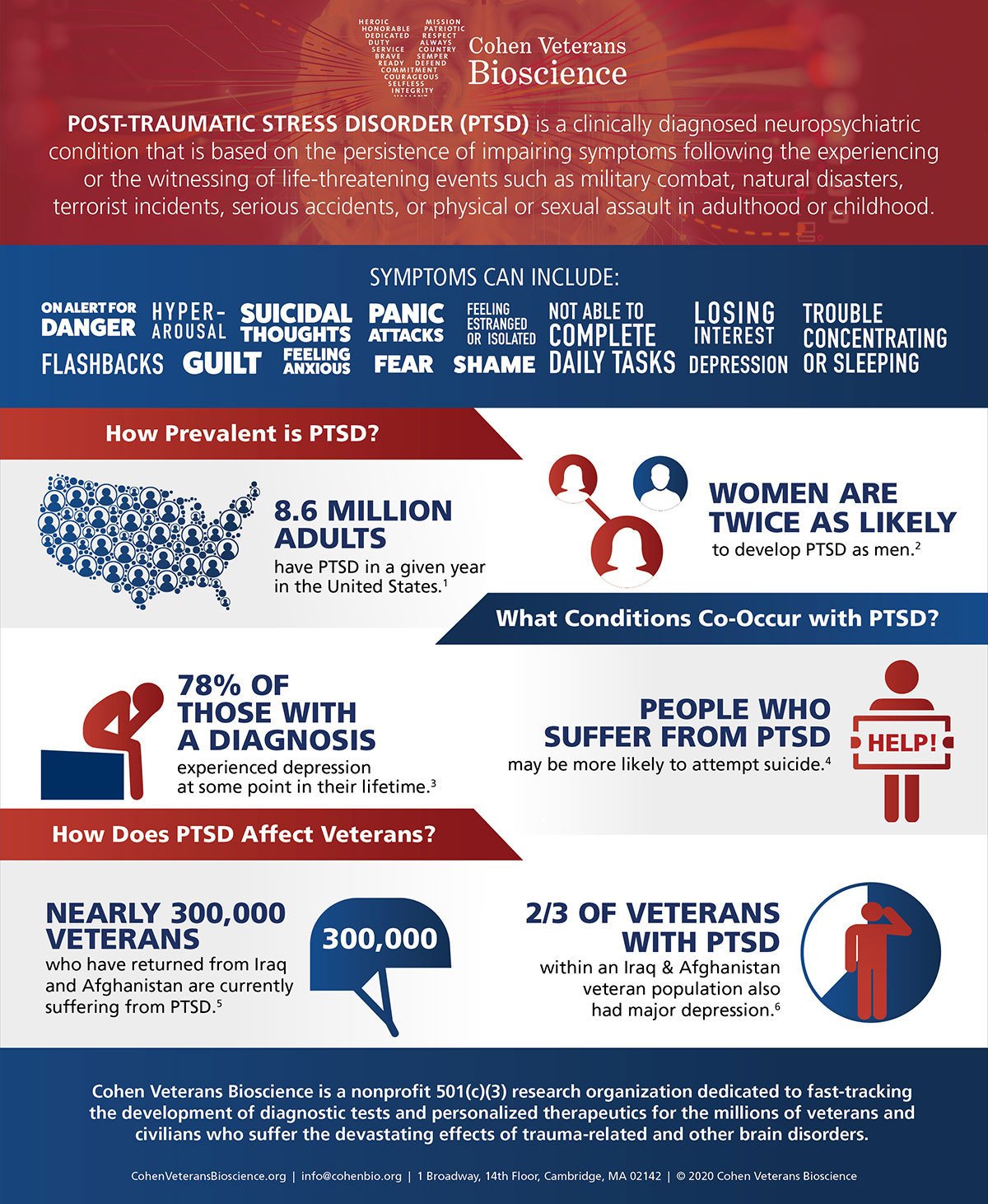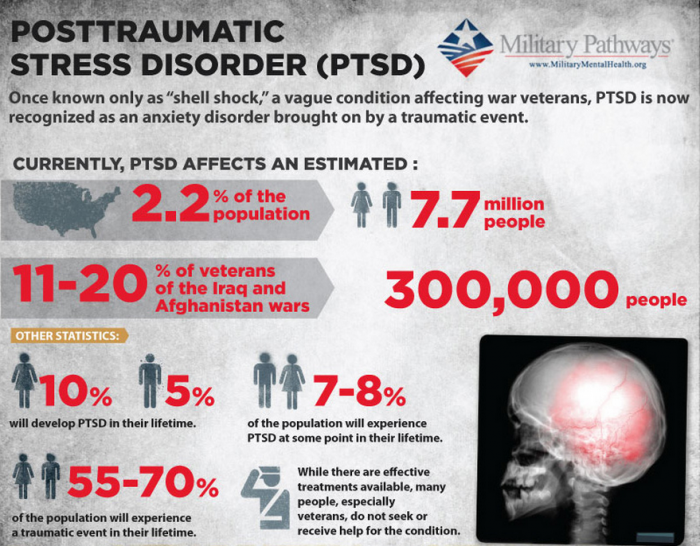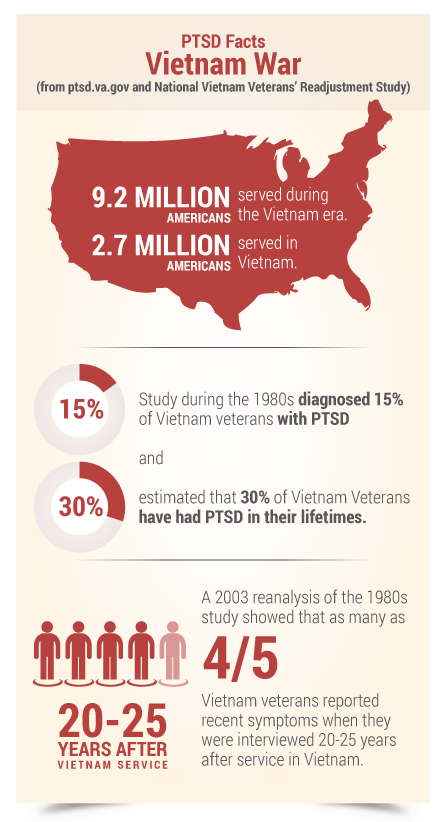Ptsd Often Goes Undiagnosed
Because of the lack of resources described above, many veterans suffer from PTSD for years without realizing that they have it. Additionally, many veterans feel shame in relation to their post-traumatic stress and avoid reporting these feelings due to fear of being perceived as weak. These individuals are often excluded from veteran PTSD statistics, so the numbers described above may be even higher. Its important that you keep this fact in mind while determining whether or not you need treatment for PTSD.
Additionally, you should remember that statistics apply to groups, not individuals. Even if you are demographically at a low risk for developing PTSD, you should still pay attention to your mental health. If you find yourself facing PTSD symptoms, especially if they come with substance abuse, its imperative that you seek help immediately. All veterans face increased risk to develop PTSD, and waiting to receive treatment can only hurt you.
Mental Health And Addiction Help In Tennessee
If you are a veteran struggling with the symptoms of PTSD or other mental health issue, we can help. At our residential, long-term and outpatient treatment centers, Cumberland Heights provides top-notch mental health care to those dealing with mental illnesses, especially those co-occurring with substance use disorders. Our dedicated staff members will walk with you every step of the way on your journey to recovery, helping you to rewrite your story.
At Cumberland Heights, weve been changing lives since 1966. To learn more about our services, contact the Cumberland Heights admissions team.
Rates Of Ptsd Among Veterans By War
Some research suggests that rates of PTSD differ among veterans who served in different military conflicts. Indeed, there is compelling statistical evidence that military personnel who served in certain wars were somewhat more likely to develop PTSD symptoms.
- Vietnam War Veterans: The National Vietnam Veterans Readjustment Study, conducted from 1986 to 1988, found that 15.2% of men and 8.1% of women who served in Vietnam met diagnostic criteria for PTSD. Additionally, the estimated lifetime prevalence of PTSD was 30.9% among men who served in Vietnam and 26.9% among women. In a more recent study, researchers also found that PTSD was more prevalent among Vietnam veterans who had served in the theater of combat.
- Gulf War Veterans: In a study of over 11,000 Gulf War veterans conducted from 1995 to 1997, researcher Han K. Kang and his colleagues found that 12.1% had PTSD at the time they were surveyed.
- Iraq and Afghanistan Veterans: In a 2008 study, researchers at the RAND Corporation analyzed the psychological health of 1,938 veterans of Operation Enduring Freedom and Operation Iraqi Freedom . OEF commenced in Afghanistan in 2001, whereas OIF launched in 2003. Among these veterans, 13.8% met criteria for PTSD at the time they were assessed.
Recommended Reading: What Is The National Disability Scheme
Veterans Need Ptsd Treatment
For American military veterans, social support and expert care are necessary to manage life-threatening PTSD symptoms. These veteran PTSD statistics show that millions of veterans need rehabilitative care, and the staff at Heroes Mile is ready to provide that care.
Our treatment center in DeLand, Florida provides care to address addiction, PTSD, and MST for veterans who need help. If you would like to learn more about our treatment options for veterans, you can fill out a digital contact form or call our admissions specialists at 1-888-VET-NOW2. With our veteran staff members, weve got your six!
for Veterans by Veterans
I Have Ptsd How Can The Ptsd Coach Canada Application Helpme

If youve been diagnosed with PTSD, the tools in the PTSD Coach Canada Application mayhelp you manage your symptoms. However, it is not meant to be a replacement for professional care. If youare currently in treatment for PTSD, you should talk with your provider about using PTSD Coach Canada as part of yourwork together.
Remember: effective treatment for PTSD is available! You dont have to live with your symptoms forever.
You May Like: How Much Does State Disability Pay
Veterans With Ptsd: Associated Health Risks
While the symptoms of PTSD can prove overwhelming in their own right, the condition is closely linked to other health risks in epidemiological research. Veterans who experience PTSD are at elevated risk for several related physical and psychological challenges. In some cases, the connection between these health problems is well understood in others, the basis of the relationship requires further exploration.
Some of the health problems linked to PTSD, either in research pertaining specifically to veterans or among individuals with PTSD more generally, are as follows:
Cannabis Can Reduce Ptsd
More supportive data for reducing PTSD rates. A study was using an app to track the changes in PTSD symptoms prior to and after using cannabis. The results show cannabis can reduce anxiety , irritability , flashbacks , and returning thoughts .
Apparently, both THC and CBD, combined together, create the overall therapeutic effect. On that note, more research is needed to fully understand these short term alleviations.
Don’t Miss: Va Disability Rating For Back Injury
Signs Of Ptsd In Veterans
According to the Diagnostic and Statistical Manual of Mental Disorders there are 4 main groups of symptoms involved with PTSD, though how you experience these symptoms may vary compared with others. Some of the symptoms can occur right after the event, but sometimes, they may not develop until years laterthere is no set timeframeand in some cases, symptoms come and go.
Regardless of when they appear, symptoms that persist for longer than 4 weeks or create difficulties in everyday life can be a sign that you or your loved one has PTSD.
The main signs and symptoms of PTSD to look for include:1
How Long Does Ptsd Last
PTSD symptoms usually appear soon after trauma. For most people, these symptoms go away on their own in thefirst few weeks and months after that. For some people, the symptoms can last for many years, especially ifthey do not seek help.
PTSD symptoms can worsen during times of stress or when people are reminded of what happened by traumatriggers . How long PTSD lasts also depends on whether effectivetreatment is received.
Recommended Reading: Is Migraine Classed As A Disability
Find Healthy Ways To Socialize And Collaborate With Veterans
There are many ways that friends and family can help veterans suffering from PTSD heal by socializing and collaborating with them.
When moving to a new base or post, the military helps military personnel and families adjust. This structure is often not automatically in place when someone separates from the military. The veteran and their family may have to find new ways to join or create a social community, according to a help sheet from the VAs Mental Health Services department.
As veterans adjust to civilian life, friends and family can help by finding and participating in activities with their loved one. This can include helping veterans in their pursuit of a new hobby or activity or introducing veterans to new social or peer groups.
PTSD is a challenging disorder that can impair the quality of life for many veterans. But with these tools and resources, both veterans and their loved ones can find ways to address PTSD and help former service members live healthy and fulfilling lives.
Negative Thoughts And Feelings
The trauma you experienced might begin to color the way you feel about the world around you and about yourself, too. You might feel depressed and hopeless. You also may have trouble connecting to other people, which could endanger important relationships.
Losing interest in activities you once enjoyed is a symptom of PTSD. You might also feel guilty or ashamed of having experienced or witnessed the trauma. Suicidal thoughts or actions are common with PTSD and are a sign that you should get help right away.
Recommended Reading: What Is Disability Insurance And What Does It Cover
Interesting Facts About Ptsd
Many people go through trauma. In fact, it is estimated that 60% of men and 50% of women will experience at least one trauma in their lives. Only a small percentage of these people, however, will develop PTSD.
The facts about PTSD state that you are most likely to develop PTSD if you:
- Were directly exposed to the trauma as a victim or a witness
- Were seriously hurt during the event
- Went through a trauma that was long-lasting or very severe
- Believed that you or a family member were in danger
- Had a severe reaction during the event, such as crying, shaking, vomiting or feeling apart from your surroundings
- Felt helpless during the trauma and were not able to help yourself or a loved one
- Had an earlier life-threatening event or trauma, such as being abused as a child
- Have another mental health problem or have a family member with a mental health problem
- Have little support from family and friends
- Have recently lost a loved one or undergone a stressful life change, especially if it was not expected
- Drink a lot of alcohol
- Are a woman
- Are younger
Ptsd Statistics By Trauma

PTSD is rooted in traumatic events. The following statistics illustrate the percentage of people who will likely develop PTSD after experiencing these traumatic events:
- Sexual assault: 49%
- Shoot and stabbing victims: 15.4%
- The unexpected death of a loved one: 14.3%
- Parents of children with life-threatening illnesses: 10.4%
- Witnesses of violence: 7.3%
Recommended Reading: Is Degenerative Disc Disease A Va Disability
Problems Associated With Combat Stress & Trauma
Exposure to combat and operational stress can leave emotional scars that linger after deployment. While every individual reacts differently, some problems service members and veterans may notice after combat or operational stress are listed below.
- Anger or Aggressive Behavior
- Although anger is a natural and healthy emotion that may have helped you do your job while deployed, intense anger can scare people and push them away. Aggressive, hurtful behavior can also cause problems with family, friends, co-workers, and the legal system.
Statistics On Ptsd Treatment And Outlook
PTSD treatment is becoming increasingly available, and PTSD treatment statistics indicate a positive outlook for treatment. One study found that as many as 46 percent of people with PTSD improved within six weeks of beginning psychotherapy. Researchers have found that as many as 62 percent of people receiving medication for PTSD show improvement. The VA recognizes the need for PTSD treatment for veterans, and PTSD treatment is now available at all VA locations. There are also nearly 200 VA locations with specialized PTSD programs.
If you or your loved one is struggling with PTSD or another mental health concern in addition to a substance use disorder, contact The Recovery Village today to learn more about our evidence-based treatment programs available at facilities across the country.
Check out the Nobu app to learn more about PTSD symptoms, diagnosis, and treatment, and connect with mental health professionals that can help. It is free and for anyone that is looking to reduce anxiety, work through depression, build self-esteem, get aftercare following treatment, attend teletherapy sessions and so much more. Download the Nobu app today!
Also Check: Do You Pay Taxes On Disability Insurance Benefits
About 8 Million Americans Suffer From Ptsd Per Annum
So is PTSD a disability? Actually, no, it belongs to the long list of mental health issues. The official PTSD definition states that this is a psychiatric disorder that occurs in people who have gone through a shock or a trauma such as a natural disaster, a serious accident, a terrorist act, war, combat, rape, or other violent personal assault. It can affect people of all ages, ethnicity, nationality, and culture.
Encourage Veterans To Join A Support Group
Even with a larger understanding of PTSD and how it impacts veterans, it may be difficult communicating with former service members about their mental health. Support groups can help veterans by providing them with a community of colleagues who have had similar experiences.
A health-related support group may fill a gap between medical treatment and the need for emotional support. A persons relationship with a doctor or other medical personnel may not provide adequate emotional support, and a persons family and friends may not understand the impact of a disease or treatment, according to an article from the Mayo Clinic. A support group among people with shared experiences may function as a bridge between medical and emotional needs.
The U.S. Department of Veterans Affairs, or VA, provides a helpful resource on how to start a support group for veterans. There may be additional support groups available from veteran, religious, nonprofit and health organizations in the veterans community. The Office of Disease Prevention and Health Promotion offer directories and resources to help access support groups for certain health afflictions. Additionally, veterans can also join digital communities on platforms including Facebook, where they can share experiences with other veterans across the world who may be suffering from similar illnesses.
You May Like: Is A Divorced Spouse Entitled To Va Disability Benefits
About 55% Of Women Veterans Were Sexually Harassed During Their Service
Furthermore, note that 23% of women in the army reported a sexual assault, such as groping, rape, etc. About 38% of men in the military experienced sexual harassment. These are some of the worst PTSD statistics about veterans.
Sexual harassment is a serious issue, no matter which gender it affects. Veteran men heavily outnumber the veteran women. In other words, over half of the veterans harassed were men, even though women were harassed more often.
Problems Related To Ptsd
Some other problems are more common for people with PTSD. These include:
- depression
- alcohol and substance use problems
- problems in relationships, work, school, or other important activities
- physical symptoms
- increased risk of medical problems
Did you know?
- More than half of men with PTSD have alcohol problems.
- Nearly half of women with PTSD also suffer from depression.
Read Also: How To Calculate Disability Retirement Pay
War Veteran Ptsd Statistics
As of 2016, there were nearly 20.4 million US veterans, with 7.1 million of them having served in the Gulf War era from 1990 to the present .2
In 2011, the US Government Accountability Office reported that around 2.6 million military service members had been deployed during the Operation Enduring Freedom and Operation Iraqi Freedom , which began in 2001 and continues to present day.3
The number of service members who develop PTSD varies by era of service, but the U.S. Department of Veterans Affairs reports that 1120 out of every 100 veterans who served in a Gulf War develop PTSD in any given year.4
Another study showed that as of 2014, the percentage of veterans with PTSD averaged around 13.5% in a representative sample of OEF/OIF-era veterans.3
Incidence Of Ptsd In Vietnam Veterans

The findings from the study mandated by Congress in 1983 were alarming. At the time of the study , among Vietnam veterans, approximately 15% of men and 9% of women were found to currently have PTSD.
Approximately 30% of men and 27% of women had PTSD at some point in their life following Vietnam.
These findings obtained approximately a decade after the end of the Vietnam War, found that for many veterans, their PTSD had become a chronic condition.
To examine the longer-term effects of chronic PTSD, researchers at the Harvard School of Public Health, Columbia University, The American Legion, and the State University of New York Downstate Medical Center surveyed 1,377 American Legionnaires who had served in Southeast Asia in the Vietnam War 14 years after their NVVRS interview in 1984.
Their study found that almost three decades after the Vietnam War, many veterans continued to experience problems with PTSD. At the initial interview, approximately 12% had PTSD. Fourteen years later, the rates of PTSD had dropped only slightly to approximately 11%. Those who had experienced high levels of combat exposure were most likely to have PTSD at both interviews.
Veterans who continued to have PTSD 14 years after their first interview were found to have considerably more psychological and social problems.
Read Also: How To File For Disability Online
Top 10 Ptsd Statistics And Facts
- PTSD patients are estimated to attempt suicide in 20% of the cases.
- People suffering from anxiety, depression, neuroticism, or those with a family history of these issues are more likely to develop PTSD.
- There is no cure for PTSD, meaning it can last during ones entire lifetime.
- Children can have PTSD too, and experience the same symptoms as adults with PTSD.
- An estimated 30% of Vietnam War veterans have experienced PTSD during their lifetime.
- Cognitive behavior treatment reduces symptoms in 21% to 46% of patients.
- About 55% of women veterans were sexually harassed during their service.
- About 30% of first responders develop behavioral conditions such as PTSD.
- 138,000 people in the US military were diagnosed with PTSD between 2000 and 2015.
- Main symptoms are hyper-arousal, avoiding everyday activities, and reliving the trauma.
